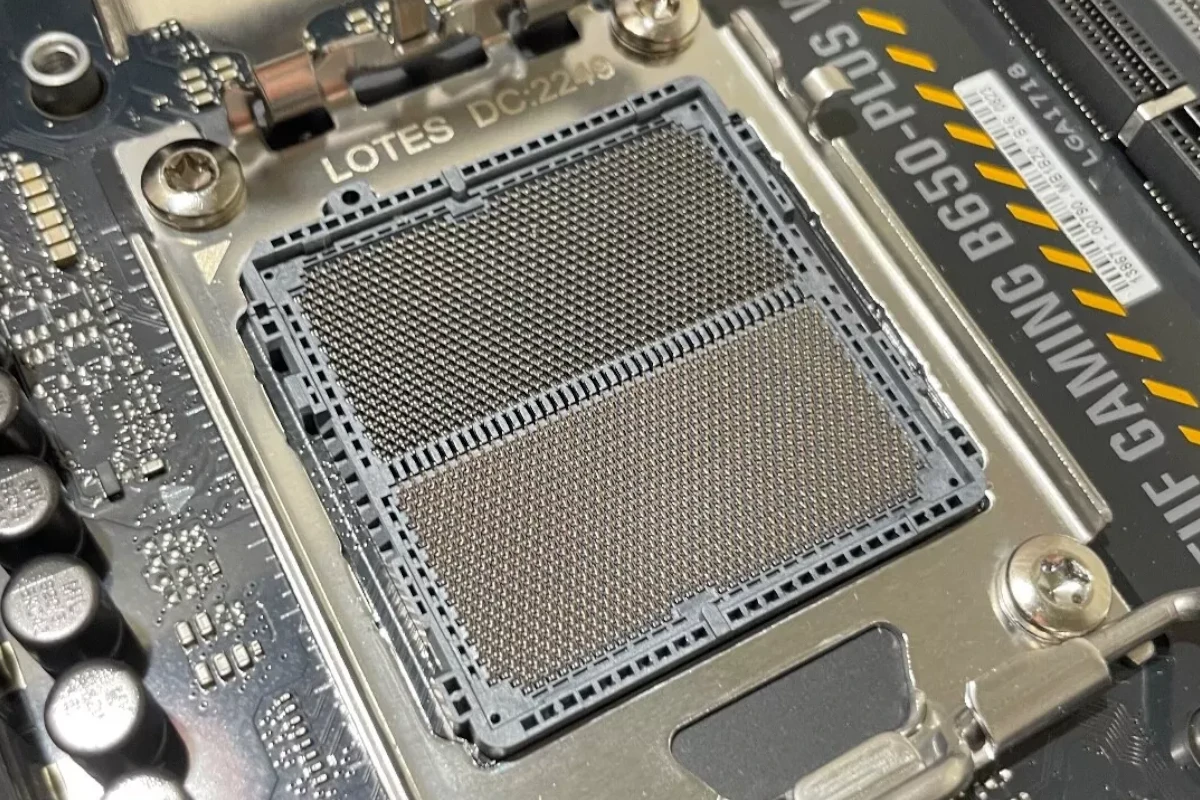AMD has made significant progress in the computer hardware industry over the years. It started with the release of its K5 processors in 1996, marking a shift from replicating Intel designs. Since then, AMD has developed various CPU sockets tailored for different processor series to meet the evolving demands of computing power. From the early Socket 7 to the more recent AM4 and AM5, AMD’s CPU sockets have evolved to support DDR4 or DDR5 memory. These advancements include integrated memory controllers, increased pin counts for better performance, and compatibility with new-age PCIe standards. These developments reflect the overall growth of the processor industry, aiming for faster, more power-efficient, and multi-functional CPU architectures alongside enhancements in semiconductor technology.
A Guide to AMD’s Sockets
AMD, a major player in the computer processor market, has released numerous CPU sockets throughout its history. Understanding the evolution of these sockets is crucial for anyone building or upgrading an AMD-powered computer.
Early Sockets
- Socket A (Socket 462): First used for AMD’s early Athlon and Duron processors marking the start of the company’s competitive designs.
- Socket 754: Primarily associated with the Athlon 64 single-core processors, introducing 64-bit computing to the AMD lineup.
- Socket 939: Successor to Socket 754, featured dual-channel memory support for higher-end Athlon 64 and Athlon 64 FX CPUs.
AM Series Sockets
- Socket AM2: Supported Athlon 64, Athlon 64 X2, and some early Phenom processors, introducing DDR2 memory support.
- Socket AM2+: Enhanced version of AM2, primarily for the Phenom and Phenom II series.
- Socket AM3: Used for Phenom II, Athlon II, and early FX processors, featuring DDR3 memory support.
- Socket AM3+: A major upgrade to AM3, mainly for the 32nm FX “Bulldozer” processors, with enhanced power delivery.
Modern Sockets
- Socket FM2/FM2+: Designed for AMD’s APUs (combining CPU and graphics), compatible with Trinity and Richland processors.
- Socket AM4: A long-lived socket, supporting Ryzen, Athlon, and some A-series processors, encompassing multiple generations of AMD’s Zen architecture.
- Socket AM5: AMD’s latest mainstream socket, designed for Ryzen 7000 series processors, offering the latest technologies like DDR5 memory and PCIe 5.0.

Understanding Compatibility
| Socket | CPU Compatibility | Memory Support | Notes |
|---|---|---|---|
| Socket A (462) | Early Athlon, Duron | DDR | |
| Socket 754 | Athlon 64 (single-core) | DDR | 64-bit |
| Socket 939 | Athlon 64 (later models), Athlon 64 X2, Athlon 64 FX | DDR | Dual-channel |
| Socket AM2 | Athlon 64, Athlon 64 X2, Phenom (early) | DDR2 | |
| Socket AM2+ | Phenom, Phenom II | DDR2 | Backward compatible with AM2 |
| Socket AM3 | Phenom II, Athlon II, FX (early) | DDR3 | |
| Socket AM3+ | FX “Bulldozer” | DDR3 | AM3 backward compatible, improved power |
| Socket FM2/FM2+ | Trinity, Richland (APUs) | DDR3 | Integrated graphics |
| Socket AM4 | Ryzen, Athlon, A-series | DDR4 | Longest-lived AMD socket |
| Socket AM5 | Ryzen 7000 series | DDR5, PCIe 5 | Newest AMD socket |
Important Note: Always confirm processor and motherboard compatibility before buying. Choosing the wrong socket means the CPU will not physically fit or work correctly.
Key Takeaways
- AMD’s journey began with K5 processors, steering away from replicating Intel’s designs.
- Socket evolution showcases increasing pin counts and integration of advanced features.
- Technological strides reflect industry trends in efficiency, performance, and functionality.
Evolution of AMD CPU Sockets
AMD has been a prominent player in the CPU industry with socket designs that have evolved over several decades. The company has introduced various sockets to support its innovations in microprocessor technology.
Early Generations and Socket Introduction
AMD began its journey by producing Intel-compatible chips and later releasing its own designs. The AM9080, AMD’s first CPU released in 1974, was an 8-bit microprocessor based on Intel’s own 8080. Advancing its technology, AMD introduced the AM2900 in 1975, a bit-slice microprocessor family, and pushed further with the AM286 in the 1980s, a second-source solution for Intel’s 80286 CPU. With the need for proprietary sockets growing, AMD launched several socket types to match its new CPU releases. Socket 1 was its first, then Socket 4 arrived for the first 32-bit processors.
Socket Development and AMD Processors
The mid-1990s saw AMD making significant strides with its own processor designs. The company’s K5 microprocessor was initially built for Socket 5 and Socket 7. These sockets were instrumental as AMD branched away from Intel compatibility. AMD then developed the Super Socket 7 to further differentiate its products. By the late ’90s, the AMD K6 series utilized this socket, providing users with enhanced performance features. With the onset of the new millennium, AMD moved away from the socket design and introduced Slot A, a departure from previous architectures, emphasizing a new approach to connecting CPUs to motherboards.
Transition to Modern CPU Sockets
As technology progressed, AMD continued to adapt. Socket A, introduced in the early 2000s, marked a return to socket-based CPUs supporting the Athlon XP and Duron processors. This period sparked a trend of increased performance and power efficiency in AMD’s designs. The transformation continued into the 2010s and beyond with the release of sockets to accommodate multicore processors and advanced functions, like DDR5 memory and PCI Express 4.0 and 5.0 interfaces. Current sockets reflect the cutting-edge requirements of modern computing, paving the way for future advancements in AMD microprocessor technology.
AMD CPU Socket Chart
| CPU Socket | Released | Processor Generation | Compatible Processors |
| Socket 5/7 | 1996 | AMD K5 | K5-75, K5-90, K5-100 |
| Socket 7 | 1997 | AMD K6 | K6, K6-2, K6-III |
| Socket A/462 | 1999 | AMD Athlon, Duron, Sempron | Athlon XP, Athlon MP |
| Socket 754 | 2003 | AMD Athlon 64, Sempron | Athlon 64 3000+, Athlon 64 FX |
| Socket 939 | 2004 | AMD Athlon 64 | Athlon 64, Athlon 64 FX |
| Socket AM2 | 2006 | Athlon 64, Athlon X2 | Athlon 64 3200+, Athlon X2 3800+ |
| AM2+ | 2008 | Athlon 64, Athlon X2, Phenom | Athlon 64 X2 3800+, Phenom II X4 940 |
| AM3 | 2009 | Phenom II, Athlon II | Phenom II X4 965, Athlon II X3 450 |
| AM3+ | 2011 | Vishera, FX | Vishera FX-8350, FX-9590 |
| FM2 | 2011 | Llano, Trinity | Llano A8-3850, Trinity A10-5800K |
| FM2+ | 2012 | Kaveri | Kaveri A10-7850K |
| AM1 | 2014 | Jaguar | Jaguar A4-1200 |
| AM4 | 2016 | Ryzen, Ryzen Threadripper | Ryzen 5 1600X, Ryzen Threadripper 1950X |
| TR4 | 2017 | Ryzen Threadripper | Ryzen Threadripper 1950X |
| AM5 | 2022 | Ryzen 7000 Series | Ryzen 7 7700X |
Technological Advancements in AMD Sockets
AMD’s journey in CPU socket innovation reflects its commitment to enhancing computing power and supporting new processor capabilities. With each advancement, AMD aims to deliver improved system performance and feature support for consumers and professionals alike.
Enhanced Performance Metrics
AMD sockets evolved to boost computer speeds and connect more hardware. Recent sockets like AM4 and AM5 have increased memory and data transfer rates. They support new DDR standards and faster PCIe lanes. With AM4 supporting DDR4 and PCIe 3.0, AM5 takes a leap to DDR5 and PCIe 4.0 or 5.0 which means quicker loading apps and smoother multitasking for users.
Introduction of the Ryzen Series
The advent of the Ryzen series marked a turning point for AMD. Ryzen processors, starting with the Ryzen 1000 series on the AM4 socket, brought high core counts to a broad audience. They offer more compute power for games and apps. The AM4 socket supported Ryzen, Athlon, and A-series chips, showing a commitment to compatibility and user choice.
Cutting-edge Architectural Changes
AMD’s architecture has seen significant upgrades, such as Zen 4, which promises notable performance gains. Chipsets paired with these sockets bring new features. Innovations in cache design and energy efficiency allow users to get more from their PCs. Each new architecture ushers in capabilities that better harness the power of the hardware, like integrated GPUs for AM4-based chips, enhancing visual performance without the need for a separate graphics card.
AMD CPU Sockets By Year
AMD has a long history of CPU sockets, each with its own set of features and supported processors. Here’s a look at some of the most popular AMD sockets over the years:
Socket Timeline
| Year | Socket Name | Supported Processors | Key Features |
|---|---|---|---|
| 1999 | Slot A | Athlon (K7) | First AMD slot-based connector, similar to Intel’s Slot 1 |
| 2000 | Socket A (Socket 462) | Athlon XP, Duron | Introduced with the Athlon XP, supported DDR memory |
| 2003 | Socket 754 | Athlon 64, Sempron | First socket for AMD64 architecture, single-channel DDR memory |
| 2004 | Socket 939 | Athlon 64, Athlon 64 X2, Opteron | Dual-channel DDR memory, improved performance |
| 2006 | Socket AM2 | Athlon 64, Athlon 64 X2, Athlon 64 FX, Sempron | Support for DDR2 memory |
| 2007 | Socket F | Opteron | Server platform, quad-channel DDR2 memory |
| 2009 | Socket AM2+ | Phenom II, Athlon II, Sempron | Improved HyperTransport, backward compatible with AM2 |
| 2009 | Socket AM3 | Phenom II, Athlon II, Sempron | Support for DDR3 memory |
| 2011 | Socket AM3+ | FX-Series, Phenom II, Athlon II | Improved power efficiency, backward compatible with AM3 |
| 2012 | Socket FM1 | Llano APUs | Integrated graphics, DDR3 memory |
| 2013 | Socket FM2 | Trinity, Richland APUs | Improved integrated graphics, DDR3 memory |
| 2014 | Socket FM2+ | Kaveri APUs | Improved integrated graphics, DDR3 memory, backward compatible with FM2 |
| 2017 | Socket AM4 | Ryzen, Athlon | Support for DDR4 memory, PCIe 3.0 |
| 2022 | Socket AM5 | Ryzen 7000, 8000, 9000 series | Support for DDR5 memory, PCIe 5.0 |
Understanding Socket Compatibility
It’s important to understand that CPUs are generally only compatible with their designated socket type. Forcing a CPU into the wrong socket can damage both the CPU and the motherboard. Always check your motherboard documentation for a list of supported processors.
If you’re planning to upgrade your CPU, it’s often necessary to upgrade your motherboard as well to ensure compatibility with the latest socket technology. This can be a significant investment, but it can also offer substantial performance improvements and access to new features.
Frequently Asked Questions
The FAQs below aim to shine a light on the AMD CPU socket release history and its various updates over time.
What is the timeline for AMD CPU socket releases?
AMD began its journey with Socket 5 in 1996. This marked the start of a series of socket releases and improvements, with new sockets being released and older ones retired as technology advanced.
Which AMD CPU socket is the latest version?
The latest AMD socket at this stage is the AM5, introduced after the long-standing AM4. It is the current foundation for the newest AMD processors.
When was the AMD Socket AM4 introduced?
AMD introduced Socket AM4 in 2016. It was a versatile foundation supporting multiple generations of Ryzen processors.
How often does AMD update their CPU socket design?
AMD updates their CPU sockets roughly every few years to accommodate new technology and processor capabilities. However, they have shown a tendency to maintain socket compatibility for longer periods whenever possible, as observed with the AM4 socket.
What are the notable differences between AMD CPU socket generations?
AMD CPU socket generations differ mainly in their pin configurations, power delivery, and chipset support. Each generation aligns with new technological standards, such as memory support and data transfer speeds.
What is the release sequence for AMD Ryzen processor sockets?
The first Ryzen processors used the AM4 socket introduced in 2016. As newer Ryzen processors have been released, they’ve often maintained compatibility with the AM4 socket until the recent transition to the AM5 socket.





